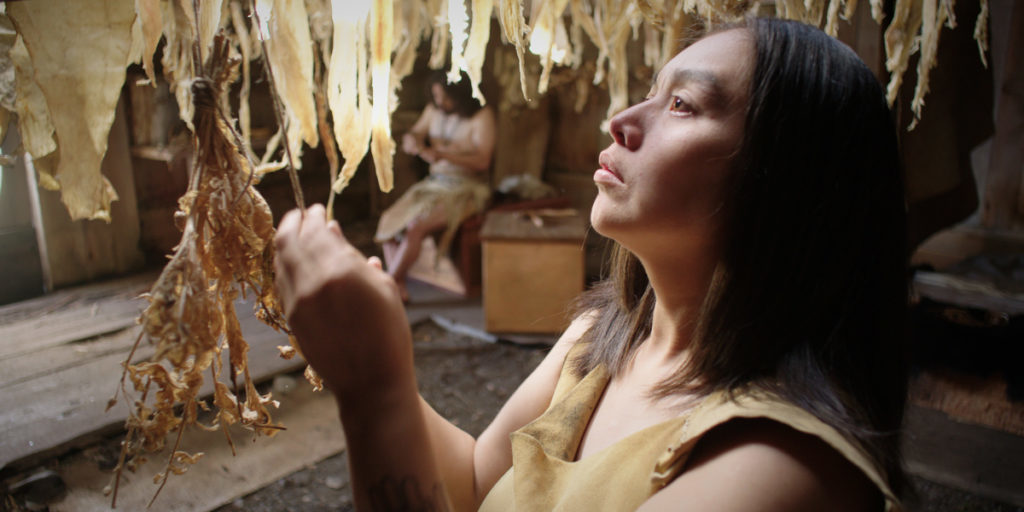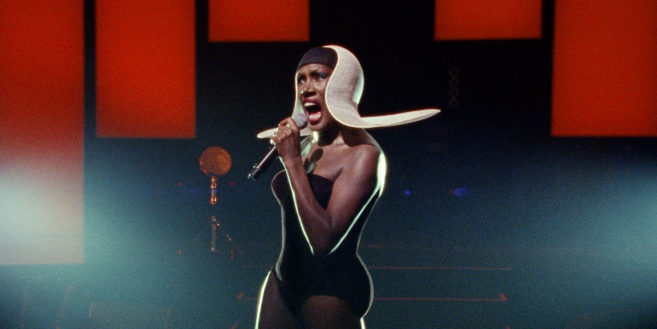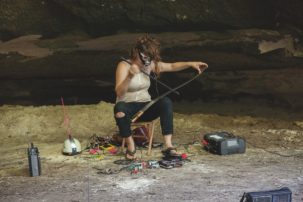As a baby, Gwaai Edenshaw used to bounce in a jolly jumper suspended from an in-progress totem pole—a totem pole in Skidegate that was being carved by Bill Reid, with his father Guujaaw helping. Years later, Gwaai apprenticed with Reid in his studio, studied jewellery-making at college, exhibited art at the Vancouver Art Gallery, had works purchased by the Canadian Museum of Civilization, assisted with developing plays in the Haida language, and helped carve totem poles too.
But where Gwaai Edenshaw has been recently is a long way from the focused, intensive solitude of a jewellery bench or the musty, outdoor, wood-chip-lined site of a carving project. This week, Edenshaw has found himself in the middle of the Toronto International Film Festival for the world premiere of Edge of the Knife—the world’s first Haida-language feature film, which he co-directed with Tsilhqot’in filmmaker Helen Haig-Brown and which focuses on Gaagiixid, “a being woven into the fabric of Haida history for millennia.”
Here, in an in-depth in-person interview, Edenshaw talks about the shift from whittling wood to shaping narrative, the similarities between potlatches and film shoots, the importance of the Haida language, and next things on the horizon.
Leah Sandals: What was it like for you to premiere the world’s first Haida-language feature film at TIFF this week? What surprised you about audience or media reaction? And what supports were here from your community?
Gwaai Edenshaw: Well, a large contingent of Haidas came, and that happens often when we do something, so it was really nice to have them along. My two sisters came; the older sister had done a lot of support work on the film and the younger sister was one of the actors in the film.
We actually had a screening on Haida G’waai before we came here to Toronto, so it’s definitely a different audience. Our audience at home is more invested in the people—so I had a worry with them, as the story unfolds and tragedies come down on the characters in the film, how prepared parts of our audience would be for those things. For the TIFF audience, I didn’t worry as much about that.
And there was a lot more laughter at home. I think probably the audiences here weren’t sure all the time whether or not it was appropriate to laugh at certain things. But also you’ve got a bit of a secret handshake when you’re in a small community, and the humour is particular. You know, a lot of young people, when they leave to go away to school or something like that, have a difficult time being away from home; and I think one of the primary elements of that is that people don’t understand their sense of humour. They’ve lived their whole lives with people who love and understand them and get them, and they might be the most hilarious person on the block—and then they leave town and all they are getting is blank stares. Not to say we got blank stares! But humour wasn’t the foundational element of our story.
LS: Where exactly did this film begin for you? How many years ago did the process start?
GE: I think it was about four years ago. One of our production managers was involved with a community development program teamed up with UBC, and they decided they would want to create a story.
So I came in on the storywriting process as part of a team of four: me, my brother Jaalan Edenshaw, Graham Richard and Leonie Sandercock. Then Isuma took our script and shopped it around, and the Haida Nation invested a substantial amount of money into the project just to get it kicked off. We got funded right away, and no small part of that would be due to our partnership with Isuma.
We felt part of the soul of our nation is wrapped up in our language. So if we wanted to tell a Haida story for ourselves or for other people, it had to be in the Haida language, or something would be missing.
LS: What were the main challenges and rewards were for you in making this film? A lot of your practice has encompassed very small-scale, solo jewellery-making process, and you’ve done collaborative playwriting before, but this was your first feature film experience.
GE: Well, you sort of hit the nail on the head there: one of the key differences in making a film is that there are so many creative people that are required to build it up. Like, I couldn’t do everything—I couldn’t even hope to do some of the things. I had to have a lot of faith in people in their own sort of areas of execution. So that was challenging for me, but particularly once we got into shooting, things just moved fast and I didn’t have a choice—I just had to let go of that and I had to trust people, and I feel like my trust was well placed. Our team was great, and I had Helen Haig-Brown working right beside me and bringing her experience in film to it.
My role, besides everything else, was making sure that the voice that we were speaking with was a Haida voice. And also I felt like a responsibility to the script: there’s a lot of things we embedded in the script, and I was happy to be along for the ride, because I could fold in that texture. I hadn’t thought, writing it, about how those kinds of things could get lost in translation if one of us hadn’t been involved. If it had been a third-party director picking up the script, they wouldn’t have thought a lot of things that really affected how we told the story.
LS: And a lot of the usual film-production process is that one person writes the film another directs it pretty far away from the writer. So it’s good that didn’t happen here.
GE: We were told when we were writing that it was important we not fill our script with the details of what’s going on [beyond dialogue], because that’s sort of stepping on the directors’ purview. But next time I’m not going to listen to that! [Laughs.]
LS: Lessons learned. I’m also curious: Were there things from your other creative processes, like jewellery or carving, that did cross over into the filmmaking process?
GE: Yes. We tried to imbue some of the elements of flow and tension into the visual landscape and the rhythm of the film. That’s not something that you can really latch on to, but I feel like it’s there.
And to be honest, it wasn’t so much the artistic practice that helped as the experience of throwing potlatches. My dad had a potlatch just a couple of months before we started shooting, and how we came together, and all the different community members were supporting him, and how everything was a scramble right up until the moment the pole was going up, or that he was being sung in—this felt like the same kind of operation. So I felt well prepared for the chaos and the moving parts, just through having that experience.
Like, when you have a potlatch or something like that, it feels like an impossible thing: you are going to feed and gift to a thousand people and you know you’re going to do it inside of this tight timeline—but after having watched my people do it again and again and pull it off in these ways that leave you feeling more powerful and closer together, I just always had faith that it was going to work out.
For most of shooting, at best, we were getting 2 scenes a day. And we ended up with 5 days left in our shooting schedule and 25 scenes to shoot. And a bunch of them were really big scenes—but somehow in the scramble that we did, we wound up getting all the scenes that we needed and having a day left over in our shooting schedule.
Over the course of shooting, there were a few things that had to be carved. I spent all night making the knife, scrambling to finish the mask and touching up a cane. That was actually a real relief to me because I was getting to use my hands and that’s a bit of a therapy thing for me.
LS: Wow. So it all came together in the end.
GE: One thing we did is we split up into two teams—we just started givn’r and, you know, some of those scenes are my favourites, where we just had to run and gun and get it: “There’s still 45 minutes of light left, let’s shoot this other scene, set it up quick!” A lot of that came down to the props and costumes teams also having to really work overtime.
One of the really difficult things for me making a movie was the time that it took. When I make a carving or a piece of jewellery, sometimes it will take a long time—like, months to a year long—and this has been years. So in the darkest moments, I’m feeling like, can I finish anything?
And over the course of shooting, there were a few things that had to be carved. I spent all night making the knife, scrambling to finish the mask and touching up a cane. So there were a few opportunities I had during the process of shooting to do that—which in the case of the mask literally meant sleepless nights—and that was actually a real relief to me because I was getting to use my hands and that’s a bit of a therapy thing for me. And also just being able to know that I could finish something!
LS: And what was it like working with Isuma?
GE: Well, the Haida Nation was the main funder, but it doesn’t happen without Isuma. Zacharias Kunuk opened all kinds of doors for us, and he talked to us about their process and experience from 25 years ago of tackling a process like this.
Though I think our experience with language was unique compared to Isuma’s. The language component was a major thing for us. Most of the people that came to us to be a part of the process from outside of our community were coming through wanting to be involved in a language project.
Now, one thing that has been asked is how important this movie is to the revitalization of the language, and I really don’t want to overstate our position, because we are riding on the coattails of all these people who have just been doing excellent work in building language capacity and infrastructure, and all that work has been ongoing for a long, long time before we came along.
I do think that this media can be an important tool for language. It’s just that we weren’t ever, like, aiming to make an educational film. It was more that we felt part of the soul of our nation is wrapped up in our language. And so if we wanted to tell a Haida story for ourselves or for other people, it had to be in the Haida language, or something would be missing.
LS: I hear you. For decades, people have been working on preserving the language and creating infrastructures for language and transferring knowledge about the language—and those people, they didn’t make a film about it, but it’s foundational! How did you learn what you have learned in Haida so far, even if you do not identify as a speaker yourself and are still learning?
CE: When I was going into kindergarten was the first year they implemented Haida language classes in school. So I was able to do Haida language as a formal class until I was in grade 9. Then I quit school to take apprenticeship, and then when I went back to school didn’t go back on Haida Gwaii so I didn’t get K to 12—but that’s the opportunity that’s there now, that you can have K to 12 Haida-language classes
But it’s just such a complicated language; people really need immersion. And I guess that’s one of our hopes around education. When me and Jalaan did a Haida-language play a few years ago, what we realized is that it is valuable just hear the language in a sustained fashion like that. But every time we wanted to present the play it we’d have to get 25 Haidas together and hope that the fish weren’t running or that the cockles weren’t blowing up….
So we decided we would do some stop-motion animations, with the idea that kids could play these and they could even be the background chatter in the home. Having a feature film is also an extension of that—our story is maybe a bit intense for background chatter in the house, but to each their own.
I would love to tackle making a film in Haida without subtitles. I feel like that would be a great challenge.
LS: So the film might provide a kind of temporary language immersion experience. What else do you hope comes of all this? What’s next for you?
GE: Well, during the script-writing process, I probably sketched out outlines for another half-dozen features. And I can’t speak for the other guys that were involved, but every once in a while I get a text from Graham and it’s like, “How about Haidas in space?” [Laughs.]
So we are keen and interested. We started pursuing another project, sort of a more documentary-style project, right in the middle of our process, but then it started getting a bit intense and we thought, we should probably just finish the first one and then see how it goes. I would love to tackle making a film in Haida without subtitles. I feel like that would be a great challenge. Because if you’re reading the subtitles, you are not watching the picture as closely and you are not really listening to the Haida as closely. I am still happy with our movie as it is, but I would definitely challenge our Haida audiences, when this becomes a DVD, to shut off the subtitles.
I’m also just dying to get back into more carving. I have a whole bunch of pieces that are on my radar. I at last delivered a piece that a very patient, dear friend of mine had been waiting on for two years. And I have a couple of other pieces that are that late from before I quit taking orders. But I am going to be carving a lot in the short term and start whittling away at the next story too.
LS: Before we end, is there anything else you want people who are curious about the film or viewing the film to know?
CE: Well, maybe something that people don’t know is that Gaagiixid is a real thing. It’s something that happens to people; you can, if you are exposed to the elements, easily and quickly slip into that state of being. I think that people are familiar with Gaagiixid as a monster story or something like that, but really, it’s about what’s going on inside of the person who is the monster—not so much anybody else being threatened by them.
One of our principals who plays Gaagiixid, Tyler York, got a little overenthusiastic when he was biting into mussels and wound up snapping one of his teeth. He wound up getting a gold tooth replacement—and it just so happens that the last Gaagiixid that we have stories about was identified by his gold tooth. So they have this serendipitous connection.
Another interesting thing is we offered the opportunity to our actors to get traditional hand-poke tattoos. We were talking to a special effects team and it was going to cost a certain amount of dollars to paint on tattoos every day. And we had already talked about the prospect of allowing our actors to tattoo themselves anyway. So we put the proposal forward, and a number of our actors wound up getting hand-poke tattoos from Corey Bulpitt and Kwiaahwah Jones at the language camp on Haida Gwaii before the film shoot. So the tattoos you see in the film are ones that really exist.
Edge of the Knife made its public world premiere at the 2018 Toronto International Film Festival on September 7. It will also be shown October 3, 4 and 5 at the Vancouver International Film Festival, and it will close the imagineNATIVE Film + Media Arts Festival on October 21 in Toronto. Edge of the Knife will be distributed by Isuma and is expected in theatres in coming months.

 A scene from Edge of the Knife, co-directed by Gwaai Edenshaw and Helen Haig-Brown.
A scene from Edge of the Knife, co-directed by Gwaai Edenshaw and Helen Haig-Brown.







